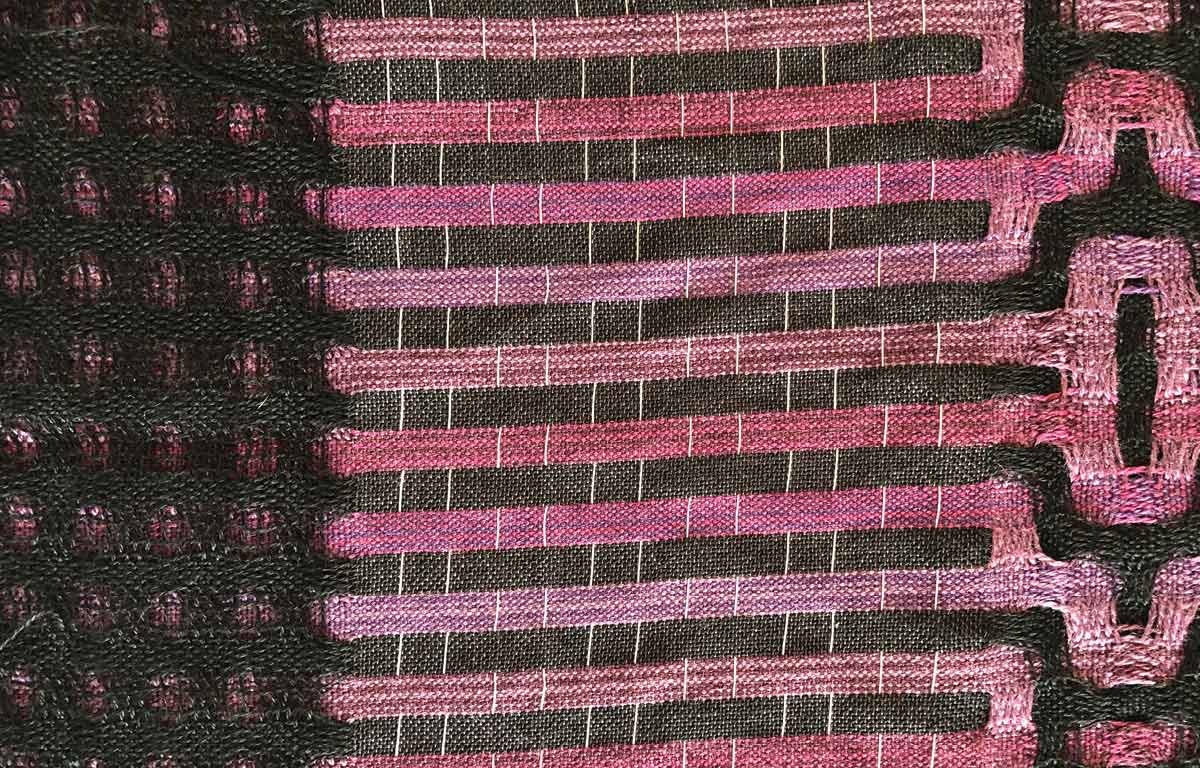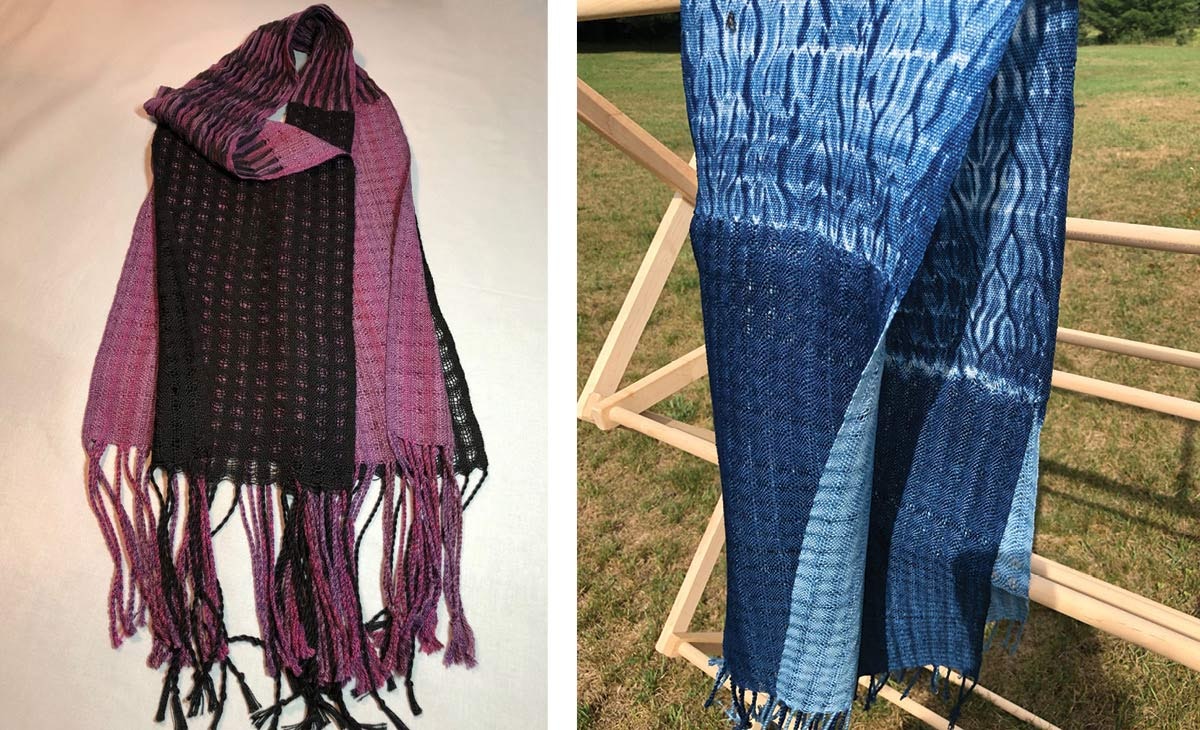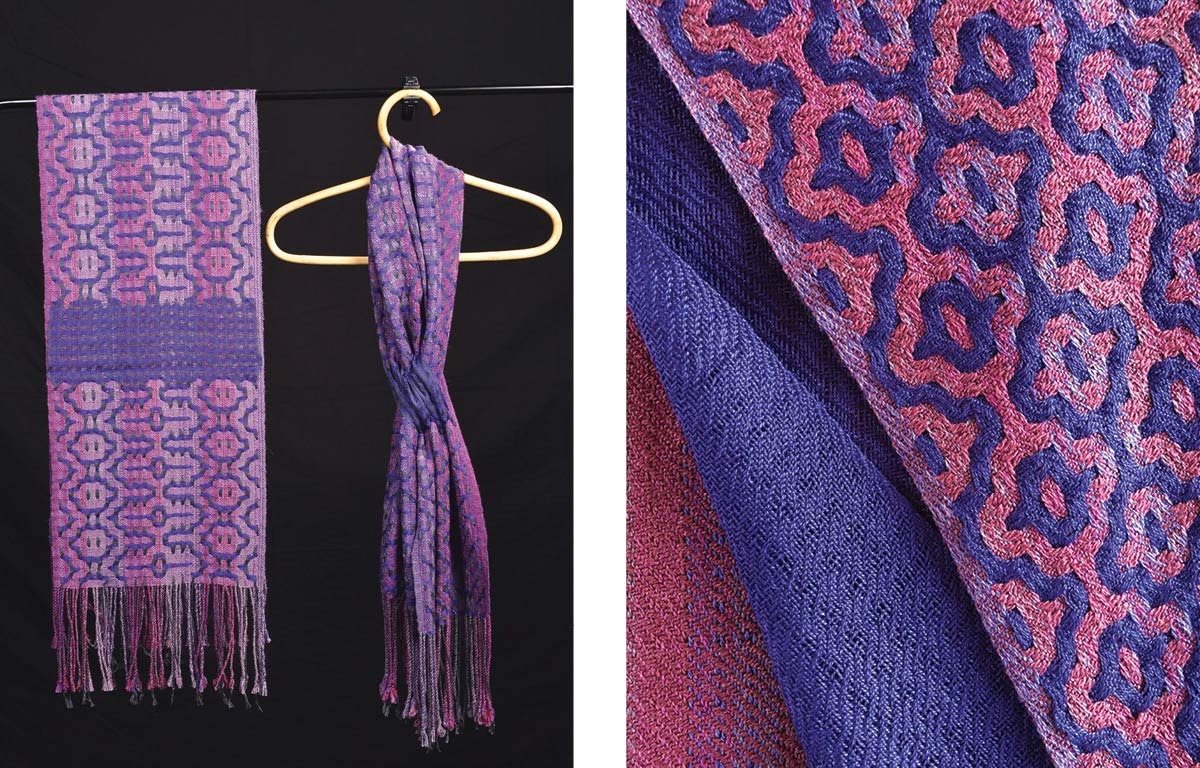Deflected doubleweave and its many variations have risen in popularity in recent years. It can be successfully woven in heavy fibers such as wool for the northern winter months as well as woven in very fine fibers such as silk, Tencel, or bamboo for warmer times. Deflected doubleweave is a weave for all seasons in my book, but the appeal is so much more than that. It’s been around for a long time, and there are many publications on the subject. In my own weaving, I’ve found that the unique properties of deflected doubleweave, once understood, can be used to create some truly wonderful complex cloth.
The Basics
While you can weave simple deflected doubleweave on four shafts, it has the most design potential on eight or more shafts. When woven on eight shafts, deflected doubleweave consists of nothing more than a combinations of warp floats, weft floats, and plain weave. Deflected doubleweave blocks are usually threaded odd-even on pairs of shafts. There may be anywhere from two to twelve threads in each block depending on the fiber selected. Floats no longer than 1/2 inch generally work well.
The designs in deflected doubleweave are often based on simple four-shaft twill block designs. Most often the threading and treadling blocks follow the principles of the “twill circle” of ABCD, where block order can change on any letter in either direction.
The simple odd-even block threading also allows you to weave plain weave. This opens up wonderful opportunities to combine plain weave with deflected doubleweave, weave layers of cloth, crimp the cloth, or weave weft-shibori for resist prior to dyeing.
Deflected doubleweave is mathematically logical to design, warp, and weave, and it’s intriguingly textural and exciting when off the loom and deflecting. Generally, the immediate questions are “How does that happen?” and, “How did you weave that?”

Crimp weave pull threads and deflected doubleweave with layers before heat is applied.
The Possibilities
I have spent the last few years weaving deflected doubleweave in what I call “Connections, Layers, and Pockets.” I found that combining deflected doubleweave with traditional multilayered doubleweave in interesting ways makes it even more exciting and dramatic—especially for scarves and shawls. Where these connections, layers, and pockets happen is at the weaver’s discretion. For instance, you could reverse the two layers at opposite ends of a woven cloth. You can create cowl-like scarves that slip over your head with layers and deflected doubleweave connections only at the shoulders, or add a simple pocket to a deflected doubleweave scarf to slip one end through. The lovely little lacy squares in the layers of the scarves happen as you alternate weaving the layers. The previous layer woven impedes the next layer from packing down. If you are careful with your beat, small windows emerge, and they are a lovely embellishment of the fabric. There are many more possibilities of combining layers with deflected doubleweave—just trust your imagination.
On an eight-shaft loom, two layers of plain weave using traditional doubleweave techniques can be combined with deflected doubleweave. A skeleton tie-up on an eight-shaft loom enables you to weave connections, layers, and pockets without ever needing to retie the loom. A conventional deflected doubleweave tie-up may be used, but needs to be modified to weave layers.
The option to weave plain-weave cloth on a deflected doubleweave threading presents additional design opportunities. For example, crimp weave can be combined with layers with or without deflected doubleweave. The threading blocks enable “pull threads” to be easily woven in. Just remember that crimp weave requires an Orlon or polyester weft fiber to retain its crimped shape after heat processing. Coincidentally, layers and crimp weave without deflected doubleweave can be done on a four-shaft loom because only two blocks are required for pull threads for crimping.
Loom-controlled weft-shibori is also possible on deflected doubleweave threadings. Pull threads may be woven in as described above and then tied tightly to create a resist prior to dyeing. Adding layers or deflected doubleweave is also possible.
On a 16-shaft loom, there are more options for combining deflected doubleweave with other structures. This can be done in many ways, and I’ve seen deflected doubleweave successfully paired side by side with bands of various twills in a vertical “stripe” format.
Alternatively, with the availability of additional shafts, the plain-weave sections of traditional deflected doubleweave we most often see can be woven in 2/2 twill or other structures giving a brand-new twist to deflected doubleweave. I chose 2/2 twill for the 16-shaft example shown here because I wanted to be sure that I could “catch” the edges with the fiber that weaves from the interior fiber selvedge on the left to the interior fiber selvedge on the right. To complement the 2/2 twill in the deflected doubleweave, I also wove the layers in 2/2 twill.

Left: The crimp-weave and deflected-doubleweave scarf fully finished with heat to create the crimped texture. Right: Scarf designed by Janney and wove by Mary Fechner using a loom-controlled weft-shibori technique. Pull threads were woven into the fabric and then tied before dyeing to create a resist. Layers of traditional doubleweave were also added to each end of the piece.
The Conclusion
With all of these design possibilities, as well as the ones I could not include here, it’s easy to see why so many weavers are turning to deflected doubleweave time and time again. It can be used to create cloths with patterns that literally pop, as well as delicately layered cloths. I hope my designs and ideas have inspired you to weave deflected doubleweave for the first time or in a new way. The possibilities are endless.

Left: Janney’s scarf Pockets uses deflected doubleweave to both create the patterning as well as a pocket through which one end of the scarf can be threaded. Right: With more shafts comes more design possibility. This 16-shaft scarf combines deflected doubleweave with 2/2 twill instead of the usual plain weave.
Resources
- Atwater, Mary. “Ancient Colonial Shawl.” In Mary Meigs Atwater Recipe Book, Series IV, No.14. Salt Lake City, Utah: Wheelwright, 1957.
- Autio, Laurie. “Using Four-Shaft Twills for Block Designs.” Explorations in Advanced Weaving Classes, 2011–2014.
- Schneider, Angela. “Skeleton Tie-Up for Deflected Doubleweave.” Presentation at Handweavers’ Guild of Connecticut, March, 2016
- Simpson, Janney. “Layers of Air Scarf.” Handwoven, November/December 2016, 50–52.
- ——— “Upon My Shoulders.” Complex Weavers Journal, February 2018, 35.
- Totten, Dianne. Crimp Weave Workshop, Area 4, Handweavers’ Guild of Connecticut, October 2014.
- Young, Muffy. “Making a New Design.” Complex Weavers Journal, October 2013, 36–38.

